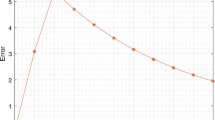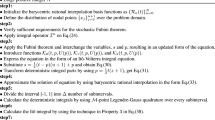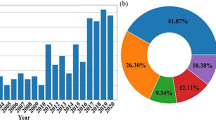Abstract
In this paper, we consider numerical approximations for the two-component PFC models for binary colloidal crystals. In addition to the Cahn–Hilliard type two-component PFC model that is commonly used for considering mass conservation, we also derived a new Allen–Cahn type two-component PFC model by using the \(L^2\)-gradient flow and add two nonlocal Lagrange multipliers to the system to conserve the mass for each component. For these two types of two-component PFC models, the stabilized scalar auxiliary variable (SAV) approach is adopted to develop efficient, decoupled, second-order accurate, and linear numerical schemes, where a new SAV is introduced to reformulate the models, and two extra linear stabilization terms are added to improve the stability and keep the required accuracy thus allowing large time steps. These schemes are unconditionally energy stable, mass conservative and require solving only four linear equations with constant coefficients at each time step. Numerical examples are performed to demonstrate the accuracy and energy stability of the proposed schemes, and numerous 2D and 3D simulations are also presented to show a variety of complex binary ordered patterns of phase transformation.
















Similar content being viewed by others
Availability of data/code and material
Date will be made available on reasonable request.
References
Alster, E., Elder, K.R., Hoyt, J.J., Voorhees, P.W.: Phase-field-crystal model for ordered crystals. Phys. Rev. E 95, 022105 (2017)
Baskaran, A., Hu, Z., Lowengrub, J.S., Wang, C., Wise, S.M., Zhou, P.: Energy stable and efficient finite-difference nonlinear multigrid schemes for the modified phase field crystal equation. J. Comput. Phys. 250, 270–292 (2013)
Baskaran, A., Lowengrub, J.S., Wang, C., Wise, S.M.: Convergence analysis of a second order convex splitting scheme for the modified phase field crystal equation. SIAM J. Numer. Anal. 51(5), 2851–2873 (2013)
Bodnarchuk, M.I., Kovalenko, M.V., Heiss, W., Talapin, D.V.: Energetic and entropic contributions to self-assembly of binary nanocrystal superlattices: temperature as the structure-directing factor. J. Am. Chem. Soc. 132(34), 11967–11977 (2010)
Cai, Z., Liu, Y.J., Lu, X., Teng, J.: Fabrication of well-ordered binary colloidal crystals with extended size ratios for broadband reflectance. ACS Appl. Mater. Interf. 6(13), 10265–10273 (2014)
Cheng, Q., Liu, C., Shen, J.: A new Lagrange multiplier approach for gradient flows. Comput. Methods Appl. Mech. Eng. 367, 113070 (2020)
Cheng, Q., Shen, J.: Global constraints preserving scalar auxiliary variable schemes for gradient flows. SIAM J. Sci. Comput. 42(4), A2489–A2513 (2020)
Dehghan, M., Abbaszadeh, M.: The meshless local collocation method for solving multi-dimensional Cahn–Hilliard, Swift–Hohenberg and phase field crystal equations. Eng. Anal. Bound. Elem. 78, 49–64 (2017)
Elder, K.R., Grant, M.: Modeling elastic and plastic deformations in nonequilibrium processing using phase field crystals. Phys. Rev. E 70, 051605 (2004)
Elder, K.R., Katakowski, M., Haataja, M., Grant, M.: Modeling elasticity in crystal growth. Phys. Rev. Lett. 88, 245701 (2002)
Elder, K.R., Provatas, N., Berry, J., Stefanovic, P., Grant, M.: Phase-field crystal modeling and classical density functional theory of freezing. Phys. Rev. B 75, 064107 (2007)
Eldridge, M., Madden, P., Frenkel, D.: Entropy-driven formation of a superlattice in a hard-sphere binary mixture. Nature 365(6441), 35 (1993)
Evers, W.H., Nijs, B.D., Filion, L., Castillo, S., Dijkstra, M., Vanmaekelbergh, D.: Entropy-driven formation of binary semiconductor-nanocrystal superlattices. Nano Lett. 10(10), 4235–4241 (2010)
Fallah, V., Stolle, J., Ofori-Opoku, N., Esmaeili, S., Provatas, N.: Phase-field crystal modeling of early stage clustering and precipitation in metal alloys. Phys. Rev. B 86, 134112 (2012)
Ganai, N., Saha, A., Sengupta, S.: Colloidal particles in a drying suspension: a phase field crystal approach. Eur. Phys. J. E 36(8), 90 (2013)
Glasner, K., Orizaga, S.: Improving the accuracy of convexity splitting methods for gradient flow equations. J. Comput. Phys. 315, 52–64 (2016)
Gomez, H., Nogueira, X.: An unconditionally energy-stable method for the phase field crystal equation. Comput. Methods Appl. Mech. Eng. 249, 52–61 (2012)
Guo, R., Xu, Y.: Local discontinuous Galerkin method and high order semi-implicit scheme for the phase field crystal equation. SIAM J. Sci. Comput. 38(1), A105–A127 (2016)
Heatley, K.L., Ma, F., Wu, N.: Colloidal molecules assembled from binary spheres under an ac electric field. Soft Matter 13(2), 436–444 (2017)
Huang, Z.F., Elder, K.R.: Mesoscopic and microscopic modeling of island formation in strained film epitaxy. Phys. Rev. Lett. 101, 158701 (2008)
Huang, Z.F., Elder, K.R.: Morphological instability, evolution, and scaling in strained epitaxial films: an amplitude-equation analysis of the phase-field-crystal model. Phys. Rev. B 81, 165421 (2010)
Huang, Z.F., Elder, K.R., Provatas, N.: Phase-field-crystal dynamics for binary systems: derivation from dynamical density functional theory, amplitude equation formalism, and applications to alloy heterostructures. Phys. Rev. E 82, 021605 (2010)
Jiang, K., Si, W.: Stability of three-dimensional icosahedral quasicrystals in multi-component systems. Philos. Mag. 100(1), 84–109 (2020)
Jiang, K., Tong, J., Zhang, P.: Stability of soft quasicrystals in a coupled-mode Swift-Hohenberg model for three-component systems. Commun. Comput. Phys. 19(3), 559–581 (2016)
Khalil, K.S., Sagastegui, A., Li, Y., Tahir, M.A., Socolar, J.E., Wiley, B.J., Yellen, B.B.: Binary colloidal structures assembled through ising interactions. Nat. Commun. 3, 794 (2012)
Kiely, C., Fink, J., Brust, M., Bethell, D., Schiffrin, D.: Spontaneous ordering of bimodal ensembles of nanoscopic gold clusters. Nature 396(6710), 444 (1998)
Kim, M.H., Im, S.H., Park, O.O.: Fabrication and structural analysis of binary colloidal crystals with two-dimensional superlattices. Adv. Mater. 17(20), 2501–2505 (2005)
Kostiainen, M.A., Hiekkataipale, P., Laiho, A., Lemieux, V., Seitsonen, J., Ruokolainen, J., Ceci, P.: Electrostatic assembly of binary nanoparticle superlattices using protein cages. Nat. Nanotechnol. 8(1), 52 (2013)
Lee, H.G., Shin, J., Lee, J.Y.: First and second order operator splitting methods for the phase field crystal equation. J. Comput. Phys. 299, 82–91 (2015)
Li, D., Qiao, Z.: On second order semi-implicit Fourier spectral methods for 2D Cahn–Hilliard equations. J. Sci. Comput. 70(1), 301–341 (2017)
Li, Q., Li, X., Yang, X., Mei, L.: Highly efficient and linear numerical schemes with unconditional energy stability for the anisotropic phase-field crystal model. J. Comput. Appl. Math. 383, 113122 (2021)
Li, Q., Mei, L.: Efficient, decoupled, and second-order unconditionally energy stable numerical schemes for the coupled Cahn–Hilliard system in copolymer/homopolymer mixtures. Comput. Phys. Commun. 260, 107290 (2021)
Li, Q., Mei, L., Yang, X., Li, Y.: Efficient numerical schemes with unconditional energy stabilities for the modified phase field crystal equation. Adv. Comput. Math. 45(3), 1551–1580 (2019)
Liu, J., Cai, Y., Deng, Y., Sun, Z., Gu, D., Tu, B., Zhao, D.: Magnetic 3-D ordered macroporous silica templated from binary colloidal crystals and its application for effective removal of microcystin. Microporous Mesoporous Mater. 130(1), 26–31 (2010)
Mu\(\check{s}\)evi\(\check{c}\), I.: Liquid Crystal Colloids. Springer, Heidelberg (2017)
Ognysta, U., Nych, A., Nazarenko, V., Skarabot, M., Musevic, I.: Design of 2D binary colloidal crystals in a nematic liquid crystal. Langmuir 25(20), 12092–12100 (2009)
Peng, Y., Lu, Y., Chen, Z., Yu, G.: A binary phase field crystal study for phase segregation of liquid phase heteroepitaxial growth. Comput. Mater. Sci. 123, 65–69 (2016)
Petris, S., Stankovich, J., Chan, D., Ottewill, R.: Modeling the structure of charged binary colloidal dispersions. Langmuir 19(4), 1121–1126 (2003)
Provatas, N., Dantzig, J., Athreya, B., Chan, P., Stefanovic, P., Goldenfeld, N., Elder, K.: Using the phase-field crystal method in the multi-scale modeling of microstructure evolution. JOM 59(7), 83–90 (2007)
Redl, F.X., Cho, K.S., Murray, C.B., O’Brien, S.: Three-dimensional binary superlattices of magnetic nanocrystals and semiconductor quantum dots. Nature 423(6943), 968 (2003)
Rubinstein, J., Sternberg, P.: Nonlocal reaction–diffusion equations and nucleation. IMA J. Appl. Math. 48(3), 249–264 (1992)
Shen, J.: Modeling and numerical approximation of two-phase incompressible flows by a phase-field approach. In: Multiscale Modeling and Analysis for Materials Simulation, Lecture Notes Series, Institute for Mathematical Sciences, National University of Singapore, Vol. 22, pp. 147–195. World Scientific, Hackensack (2012)
Shen, J., Xu, J., Yang, J.: The scalar auxiliary variable (SAV) approach for gradient flows. J. Comput. Phys. 353, 407–416 (2018)
Shen, J., Xu, J., Yang, J.: A new class of efficient and robust energy stable schemes for gradient flows. SIAM Rev. 61(3), 474–506 (2019)
Shen, J., Yang, X.: Numerical approximations of Allen–Cahn and Cahn–Hilliard equations. Discrete Contin. Dyn. Syst. 28(4), 1669–1691 (2010)
Shevchenko, E.V., Talapin, D.V., Kotov, N.A., O’Brien, S., Murray, C.B.: Structural diversity in binary nanoparticle superlattices. Nature 439(7072), 55 (2006)
Shin, J., Lee, H.G., Lee, J.Y.: First and second order numerical methods based on a new convex splitting for phase-field crystal equation. J. Comput. Phys. 327, 519–542 (2016)
Stirner, T., Sun, J.: Molecular dynamics simulation of the structural configuration of binary colloidal monolayers. Langmuir 21(14), 6636–6641 (2005)
Stolle, J., Provatas, N.: Characterizing solute segregation and grain boundary energy in binary alloy phase field crystal models. Comput. Mater. Sci. 81, 493–502 (2014)
Stolle, J.F.: Phase field crystal studies of strain-mediated effects in the thermodynamics and kinetics of interfaces. Ph.D. thesis, McMaster University, Hamilton (2014)
Taha, D., Dlamini, S.R., Mkhonta, S.K., Elder, K.R., Huang, Z.F.: Phase ordering, transformation, and grain growth of two-dimensional binary colloidal crystals: a phase field crystal modeling. Phys. Rev. Mater. 3, 095603 (2019)
Taha, D., Mkhonta, S.K., Elder, K.R., Huang, Z.F.: Grain boundary structures and collective dynamics of inversion domains in binary two-dimensional materials. Phys. Rev. Lett. 118, 255501 (2017)
Tegze, G., Bansel, G., Tóth, G.I., Pusztai, T., Fan, Z., Gránásy, L.: Advanced operator splitting-based semi-implicit spectral method to solve the binary phase-field crystal equations with variable coefficients. J. Comput. Phys. 228(5), 1612–1623 (2009)
Tegze, G., Gránásy, L., Tóth, G.I., Douglas, J.F., Pusztai, T.: Tuning the structure of non-equilibrium soft materials by varying the thermodynamic driving force for crystal ordering. Soft Matter 7(5), 1789–1799 (2011)
van Teeffelen, S., Backofen, R., Voigt, A., Löwen, H.: Derivation of the phase-field-crystal model for colloidal solidification. Phys. Rev. E 79, 051404 (2009)
Wan, Y., Cai, Z., Xia, L., Wang, L., Li, Y., Li, Q., Zhao, X.: Simulation and fabrication of binary colloidal photonic crystals and their inverse structures. Mater. Lett. 63(24–25), 2078–2081 (2009)
Wang, C., Wise, S.M.: An energy stable and convergent finite-difference scheme for the modified phase field crystal equation. SIAM J. Numer. Anal. 49(3), 945–969 (2011)
Wang, P.Y., Pingle, H., Koegler, P., Thissen, H., Kingshott, P.: Self-assembled binary colloidal crystal monolayers as cell culture substrates. J. Mater. Chem. B 3(12), 2545–2552 (2015)
Yang, X., Han, D.: Linearly first- and second-order, unconditionally energy stable schemes for the phase field crystal model. J. Comput. Phys. 330, 1116–1134 (2017)
Yang, Y., Fu, L., Marcoux, C., Socolar, J.E., Charbonneau, P., Yellen, B.B.: Phase transformations in binary colloidal monolayers. Soft Matter 11(12), 2404–2415 (2015)
Zhang, J., Yang, X.: Numerical approximations for a new \(L^2\)-gradient flow based phase field crystal model with precise nonlocal mass conservation. Comput. Phys. Commun. 243, 51–67 (2019)
Zhang, J., Yang, X.: On efficient numerical schemes for a two-mode phase field crystal model with face-centered-cubic (FCC) ordering structure. Appl. Numer. Math. 146, 13–37 (2019)
Acknowledgements
The authors would like to thank the editor and reviewers for careful reading, helpful comments and suggestions. The first author would like to thank Xiaofeng Yang at the University of South Carolina for the valuable discussions. Q. Li’s work is supported by the Fundamental Research Funds for the Central Universities, CHD (No. 300102121302). L. Mei’s work is supported by the Science Challenge Project (No. TZ2016002).
Author information
Authors and Affiliations
Corresponding author
Ethics declarations
Conflict of interest
The authors declare that they have no known competing financial interests or personal relationships that could have appeared to influence the work reported in this paper.
Additional information
Publisher's Note
Springer Nature remains neutral with regard to jurisdictional claims in published maps and institutional affiliations.
Rights and permissions
About this article
Cite this article
Li, Q., Mei, L. Numerical Approximation of the Two-Component PFC Models for Binary Colloidal Crystals: Efficient, Decoupled, and Second-Order Unconditionally Energy Stable Schemes. J Sci Comput 88, 60 (2021). https://doi.org/10.1007/s10915-021-01564-2
Received:
Revised:
Accepted:
Published:
DOI: https://doi.org/10.1007/s10915-021-01564-2
Keywords
- Binary colloidal crystals
- Phase-field crystal model
- Decoupling
- Unconditional energy stability
- SAV approach




